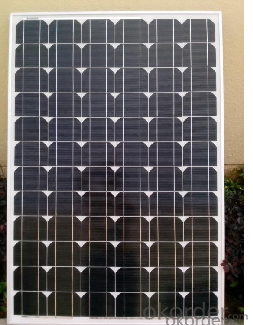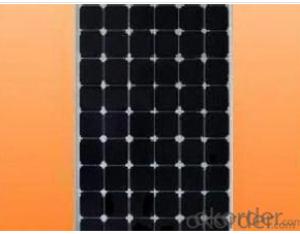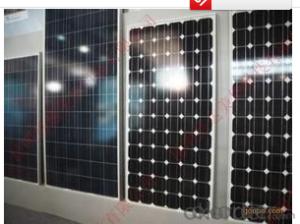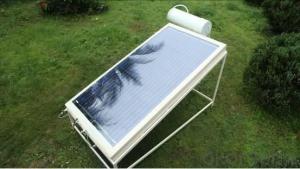Wholesale Mono Silicon Solar Panel 85W-100W Products
- Loading Port:
- China main port
- Payment Terms:
- TT or LC
- Min Order Qty:
- 1 pc
- Supply Capability:
- 200000000 pc/month
OKorder Service Pledge
OKorder Financial Service
You Might Also Like
1.Product Description:
Mono Silicon Solar Panel(85W—100W)
Introduction of Mono Silicon Solar Panel(85W-100W)
Solar photovoltaic (PV) Panel is designed for large electrical power requirements.
It is the optimal choice for both on-grid and off-grid power systems. CNBM Solar panel offers high performance of power per square foot of solar array. Monocrystalline silicon(c-Si): often made using the Czochralski process. Single-crystal wafer cells tend to be expensive, and because they are cut from cylindrical ingots, do not completely cover a square solar cell module without a substantial waste of refined silicon. Hence most c-Si panels have uncovered gaps at the four corners of the cells.
2.Characteristics of Mono Silicon Solar Panel
I Solar Cell : High efficiency crystalline solar cell. Even if under the weak light, the solar module can produce maximum power output.
II Tempered glass (toughened glass): Anti-reflecting coating and high transmission rate glass increase the power output and mechanical strength of solar module.
III EVA and TPT: Using high quality EVA and TPT to prevent destroying and water
IV AI frame: Without screw, corner connection. 6 holes on the frame can be installed easily.
V Junction box: Multi function junction box with water proof.
VI Long lifetime: ≥25 years; Less power decrease.
VII Good performance of preventing from atrocious weather such as wind and hails.
VIII Resisting moisture and etching effectively, not effected by geology.
3.Standard Test Conditions of Mono Silicon Solar Panel
The opto-electrical specifications shown below are stabilized values being measured at Standard Test Conditions, Irradiance: 1000W/m2, Spectrum: AM1.5 at 25°C, The info below is subject to manufacturing tolerances. Where appropriate minutes of measurement are available and are used for the dimensioning of the installation.
4.Images:

5.What's the advantages of your products?
Advantages of Mono Silicon Solar Panel
• CNBM Solar performance guarantees for 25 years
• 2 years guarantee for workmanship
• Timeliness of delivery
CNBM International Corporation's products including Monocrystalline Solar Panel, Polycrystalline Solar Panel have received and enjoyed famous reputation in many countries and regions in the world .As a solar panel supplier in China, we strive to provide our customers with excellent service, superior products and unmatched value.
Max Power Voltage Vmp (V) | 17.8V | 18.0V | 18.2V | 18.4V |
Max Power Current Imp (A) | 4.78A | 5.00A | 5.22A | 5.43A |
Open Circuit Voltage Voc (V) | 22.4V | 22.6V | 22.8V | 23.0V |
Short Circuit Current Isc (A) | 5.13A | 5.31A | 5.56A | 5.89A |
Max Power Pm (W) | 85W | 90W | 95W | 100W |
Temperature Coefficient of Cells
NOCT | 47℃±2℃ |
Temperature Coefficients of Isc (%/℃) | 0.064 |
Temperature Coefficients of Voc (%/℃) | -0.33 |
Temperature Coefficients of Pmp (%/℃) | -0.45 |
Mechanical Data Mono Silicon Solar Panel
Power | 85W/90W/95W/100W |
Dimension | 1190×550×30mm |
Weight | 8kg |
Tolerance | ±3% |
The dimension of the modules can be changed according to the demand of clients
Limits
Operating Temperature | –40 °C to +85°C |
Storage Temperature | –40 °C to +85°C |
Max System Voltage | 700V |
Guarantee of Mono Silicon Solar Panel
Products Guarantee | 2 yrs free from defects in materials and workmanship |
Performance Guarantee | No less than 90% within 10yrs and no less than 80% within 20yrs |
Certificates | IEC, ISO, TUV, CE |
Solar cell technologies
New ‘black diamond’ technology which can double solar cell efficiency
Black diamond’ is an innovative concept that promises to change the future of solar technology, potentially exceeding 50 per cent efficiency in solar concentration systems. Diamonds satisfy two of the three conditions necessary for solar radiation capture – being able to withstand extremely high temperatures, and having the ability to emit electrons efficiently – but, because of their transparency, they are unable to adequately interact with sunlight. The team’s creation of the ‘black diamond’ fulfils this third condition and can harness solar radiation at temperatures up to 1000 °C, according to the researchers.
Next Energy Technologies Turning Windows into Solar Panels
The next time you walk by an office building or are inside looking out, pay close attention to the windows. Chances are they’re heavily tinted to reduce computer glare and to absorb heat, helping the building to stay cooler. In fact, many windows block half the sunlight entering a room, reflecting the rest of the solar energy back into the world. The small-molecule technology is based on organic semiconductors pioneered at UCSB under Alan Heeger, who won a Nobel Prize for his work in 2000. The window arrays will act just like a big solar field, connected in a grid attached to a power inverter. Some day down the line, the ink may be printed on flexible materials such as tents or awnings, or incorporated into roof materials. It may also be used for lightweight, portable generation in developing countries.
Advances in crystalline silicon solar cell technology for industrial mass production
Crystalline silicon photovoltaic (PV) cells are used in the largest quantity of all types of solar cells on the market, representing about 90% of the world total PV cell production in 2008. Crystalline silicon solar cells are also expected to have a primary role in the future PV market. We can learn the current technologies used for the production and application of crystalline silicon PV cells. The highest energy conversion efficiency reported so far for research crystalline silicon PV cells is 25%. Standard industrial cells, however, remain limited to 15–18% with the exception of certain high-efficiency cells capable of efficiencies greater than 20%. High-efficiency research PV cells have advantages in performance but are often unsuitable for low-cost production due to their complex structures and the lengthy manufacturing processes required for fabrication. Various technologies for mono- and polycrystalline PV cells are compared and discussed with respect to the corresponding material technologies, such as silicon ingot and wafer production. High energy conversion efficiency and low processing cost can only be achieved simultaneously through the development of advanced production technologies and equipment, and some of the latest technologies that could lead to efficiencies of greater than 25% and commercially viable production costs are reviewed.
- Q:Can solar cells be used to power water purification systems?
- Yes, solar cells can be used to power water purification systems. Solar-powered water purification systems use the energy from the sun to generate electricity, which is then used to power pumps, filters, and other components of the water purification process. This sustainable and renewable energy source makes solar cells an effective and environmentally friendly solution for powering water purification systems, especially in areas with limited access to electricity grids.
- Q:Can solar cells be used for powering drones?
- Yes, solar cells can be used for powering drones. Solar-powered drones are becoming increasingly popular as they offer longer flight times and reduce the need for frequent battery replacements or recharges. By harnessing sunlight, solar cells convert solar energy into electrical energy, which can be used to power and charge the drone's batteries. This sustainable and renewable energy source allows drones to fly for extended periods, making them more efficient and environmentally friendly.
- Q:Are there any library or exhibition halls where I can show students at school how the solar cells works?
- Sometimes there are some theme shows focused on solar cell technology in the National Science and technology Museum. You can take your students over there.
- Q:How does the size of a solar cell affect its performance?
- The size of a solar cell directly affects its performance. Generally, larger solar cells can generate more electricity as they have a larger surface area to collect sunlight. This means they can absorb more photons and convert them into electrical energy. Additionally, larger solar cells tend to have lower resistance and better efficiency. However, larger cells also require more materials and are more expensive to produce. Therefore, the optimal size of a solar cell depends on various factors, including the available space, budget, and desired energy output.
- Q:Can solar cells be used for powering medical devices?
- Yes, solar cells can be used for powering medical devices. Solar cells convert sunlight into electricity, which can be harnessed to provide power to various devices including medical equipment. This is particularly useful in remote areas or during emergencies where access to traditional power sources may be limited or unavailable. Additionally, solar-powered medical devices can be more sustainable and cost-effective in the long run.
- Q:Are solar cells affected by shade?
- Yes, solar cells are significantly affected by shade. Even a small amount of shade can cause a significant decrease in the power output of solar cells.
- Q:Can solar cells be used in disaster recovery efforts?
- Yes, solar cells can be used in disaster recovery efforts. They are a reliable and sustainable source of energy that can provide electricity to power essential devices and equipment in disaster-stricken areas. Solar cells can be used to charge communication devices, provide lighting, run medical equipment, and support temporary shelters. Their portability and ability to operate off-grid make them particularly valuable in situations where traditional power sources are disrupted or inaccessible. Additionally, solar cells can contribute to reducing the reliance on fossil fuels during recovery efforts, promoting a cleaner and more sustainable path towards rebuilding communities affected by disasters.
- Q:Can solar cells be used to power electric vehicle charging stations?
- Yes, solar cells can be used to power electric vehicle charging stations. Solar panels can generate electricity from sunlight, which can be stored in batteries or directly used to charge electric vehicles. This renewable energy source can reduce reliance on the grid and contribute to a more sustainable and environmentally-friendly charging infrastructure.
- Q:Can solar cells be used in telecommunications systems?
- Yes, solar cells can be used in telecommunications systems. Solar cells are capable of converting sunlight into electricity, which can power various telecommunications equipment such as base stations, repeaters, and remote monitoring systems. This allows for reliable and independent power supply in remote areas or during power outages, making solar cells an energy-efficient and sustainable solution for telecommunications systems.
- Q:Can solar cells be used on windows?
- Yes, solar cells can be used on windows.
1. Manufacturer Overview |
|
|---|---|
| Location | |
| Year Established | |
| Annual Output Value | |
| Main Markets | |
| Company Certifications | |
2. Manufacturer Certificates |
|
|---|---|
| a) Certification Name | |
| Range | |
| Reference | |
| Validity Period | |
3. Manufacturer Capability |
|
|---|---|
| a)Trade Capacity | |
| Nearest Port | |
| Export Percentage | |
| No.of Employees in Trade Department | |
| Language Spoken: | |
| b)Factory Information | |
| Factory Size: | |
| No. of Production Lines | |
| Contract Manufacturing | |
| Product Price Range | |
Send your message to us
Wholesale Mono Silicon Solar Panel 85W-100W Products
- Loading Port:
- China main port
- Payment Terms:
- TT or LC
- Min Order Qty:
- 1 pc
- Supply Capability:
- 200000000 pc/month
OKorder Service Pledge
OKorder Financial Service
Similar products
New products
Hot products
Hot Searches
Related keywords





























